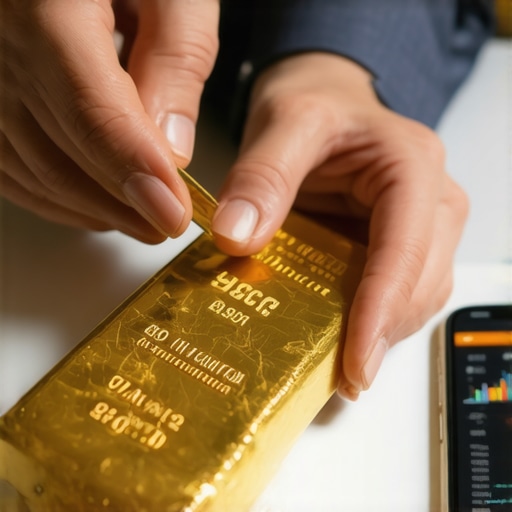Understanding the Basics of Gold Investment
Investing in gold has long been regarded as a safe haven for wealth preservation and an effective hedge against inflation. For beginners looking to enter the gold market in 2025, it’s crucial to grasp the foundational concepts that govern this precious metal’s investment landscape. In this quick guide, we will explore essential aspects of investing in gold, including different forms of gold investments, market dynamics, and practical tips for beginners.
Why Invest in Gold?
Gold has historically maintained its value, making it an attractive option for investors. During economic downturns or periods of high inflation, gold often outperforms other assets, providing a sense of security. As a tangible asset, gold can also diversify your investment portfolio, helping to mitigate risks associated with stocks and bonds. For those wondering about the role of gold in a diversified investment portfolio, it serves as a buffer against market volatility.
Types of Gold Investments
When it comes to investing in gold, several options are available:
- Physical Gold: This includes gold bars, coins, and jewelry. Physical gold allows investors to hold a tangible asset, but it also requires secure storage.
- Gold ETFs: Exchange-Traded Funds (ETFs) are a popular choice for beginners, as they offer exposure to gold without the need to store physical bullion. ETFs track the price of gold and can be traded like stocks.
- Gold Mining Stocks: Investing in companies that mine gold can provide exposure to gold prices while potentially offering dividends. However, it comes with additional risks associated with the mining industry.
- Gold Mutual Funds: These funds pool investors’ money to purchase a mix of gold-related assets, including stocks of gold mining companies and gold bullion.
Understanding these options will help you make informed decisions based on your investment goals and risk tolerance.
Market Dynamics Influencing Gold Prices
As an aspiring gold investor, it’s essential to stay informed about the factors that influence gold prices. Key elements include:
- Global Economic Conditions: Economic stability or instability can significantly affect gold demand. During uncertain times, investors flock to gold as a safe haven.
- Inflation Rates: Rising inflation often leads to increased gold prices, as investors seek to preserve their purchasing power.
- Central Bank Policies: Central banks’ buying and selling of gold can impact its market value. Notably, central bank gold purchases can signal market confidence or uncertainty.
For a deeper understanding of the current and future trends in gold prices, check out the insights on gold price forecasts for 2025.
Tips for First-Time Gold Investors
As you embark on your journey of investing in gold in 2025, consider these tips:
- Start Small: If you’re new to gold investing, consider starting with a small amount to gauge your comfort level and understanding of the market.
- Research Thoroughly: Familiarize yourself with gold market trends, investment strategies, and the various forms of gold investments available.
- Diversify Your Portfolio: Don’t put all your eggs in one basket. Diversifying your investments, including gold, can help manage risk.
By following these guidelines and staying informed about the gold market, you’ll be well-equipped to navigate your investment journey. Keep an eye on gold demand trends as they evolve throughout the year.
Understanding Gold Trading Techniques
As you dive deeper into the world of gold investment, acquiring effective gold trading techniques is essential for optimizing your buying and selling strategies. Mastering these techniques can help you navigate the complexities of the gold market, ensuring that you make informed decisions and maximize your returns.
Technical Analysis in Gold Trading
One of the most critical aspects of successful gold trading is technical analysis. This method involves analyzing price charts and historical data to identify trends and potential price movements. By studying patterns such as support and resistance levels, moving averages, and trading volume, you can gain insights into future price behavior. For those interested in learning more about how technical analysis can enhance your trading strategy, consider exploring effective gold trading techniques.
Fundamental Analysis: Understanding Market Influencers
In addition to technical analysis, fundamental analysis plays a crucial role in understanding gold price fluctuations. This approach focuses on evaluating economic indicators, geopolitical events, and market sentiment that impact gold demand and supply. For example, central bank policies, inflation rates, and global economic conditions can significantly influence gold prices. Staying abreast of these factors will help you make educated decisions regarding when to buy or sell gold.
Utilizing Gold ETFs for Accessibility
For beginners, gold Exchange-Traded Funds (ETFs) offer an accessible avenue for investment. These funds track the price of gold and can be traded like stocks, allowing investors to gain exposure to gold without the complexities of physical ownership. Investing in gold ETFs can be an excellent way to diversify your portfolio, providing a balance between risk and potential returns. If you’re considering this route, check out our guide on understanding gold ETFs.
Risk Management Strategies for Gold Investors
Mitigating risks is paramount in gold investment, especially for beginners. Implementing proper risk management strategies can safeguard your investments from market volatility. Some effective strategies include setting stop-loss orders, diversifying your gold holdings, and regularly reviewing your investment portfolio. Understanding your risk tolerance and remaining informed about market changes will enable you to adjust your strategies accordingly.
Market Trends: What to Watch in 2025
As we move into 2025, keeping an eye on gold market trends is vital for making informed investment decisions. Analysts are predicting several factors that could influence gold prices this year:
- Inflation and Monetary Policy: With ongoing concerns about inflation, investors may increasingly turn to gold as a hedge, potentially driving prices higher.
- Geopolitical Tensions: Any instability in global politics can lead to increased demand for gold as a safe-haven asset.
- Technological Advancements: Innovations in gold mining and trading technologies may also shape market dynamics, making it crucial to stay updated.
For a more comprehensive overview of what to expect in the gold market this year, consider reading about key factors for investors.
Final Thoughts on Gold Investment in 2025
Investing in gold in 2025 presents both opportunities and challenges. By understanding the basics of gold investment, utilizing effective trading techniques, and keeping abreast of market trends, you can position yourself as a knowledgeable and strategic investor. The journey into gold investment is just beginning, and with the right approach, you can make informed decisions that pave the way for financial success.
Advanced Gold Investment Strategies for 2025
As you delve deeper into the world of gold investment, understanding advanced strategies can significantly enhance your portfolio’s performance. In 2025, the gold market is expected to present unique opportunities, and leveraging sophisticated techniques can position you for success. Here, we will explore various advanced strategies that experienced investors employ to maximize their returns.
Hedging with Gold Options and Futures
One of the most effective ways to manage risk in your gold investments is through options and futures contracts. These financial instruments allow you to speculate on the future price of gold without owning the physical asset. By using gold futures, you can lock in prices today for purchases in the future, which can be a strategic move during times of volatility.
Investing in Gold Mining Stocks
For those looking to gain exposure to gold prices with the potential for higher returns, investing in gold mining stocks can be an attractive option. These stocks often move in correlation with gold prices, but they can offer additional upside through company performance and dividends. However, be mindful of the unique risks associated with mining operations, including geopolitical factors and operational costs.
Utilizing Gold IRAs for Long-Term Growth
Another advanced strategy is investing in a Gold IRA (Individual Retirement Account). This allows you to hold physical gold in a retirement account, providing tax advantages while diversifying your retirement portfolio. If you’re considering this route, it’s essential to understand the rules governing Gold IRAs, including eligible types of gold and storage requirements. For detailed insights, check out our guide on Gold IRAs.
Market Timing: When to Buy and Sell Gold
Timing your investments can significantly impact your returns. Experienced investors often utilize market analysis to identify optimal buying and selling points based on economic indicators, gold price trends, and geopolitical developments. Staying informed about gold price trends can help you make more strategic decisions regarding your gold investments.
Leveraging Gold ETFs for Strategic Allocation
Gold Exchange-Traded Funds (ETFs) offer a flexible way to gain exposure to gold without the complexities of physical ownership. They can be particularly useful for tactical asset allocation strategies. By monitoring market conditions, you can adjust your holdings in gold ETFs to reflect your investment goals. For a comprehensive understanding of this investment type, refer to our post on gold ETFs.
Analyzing Global Economic Indicators
Keeping a close watch on global economic indicators is vital for gold investors. Factors such as interest rates, inflation rates, and currency strength can influence gold prices significantly. By understanding these economic indicators, you can anticipate market shifts and adjust your investment strategy accordingly. For further reading, explore our insights on gold price dynamics.
As you develop your gold investment strategy for 2025, remain vigilant and adaptable to changing market conditions. The gold market is dynamic, and being well-prepared will give you a competitive edge.
Navigating Gold Investment Risks in 2025
As with any investment, investing in gold comes with its own set of risks. Understanding and managing these risks is crucial for maximizing returns and ensuring long-term success in the gold market. In this section, we will explore the various risks associated with gold investment and strategies to mitigate them effectively.
Market Volatility and Price Fluctuations
Gold prices can be highly volatile, influenced by a multitude of factors such as economic conditions, geopolitical tensions, and changes in monetary policy. This volatility can lead to significant price fluctuations, making it essential for investors to stay informed about gold price trends. To navigate this risk, consider implementing a disciplined investment strategy that includes regular portfolio reviews and adjustments based on market conditions.
Storage and Security Concerns
For those investing in physical gold, security is a significant concern. Safeguarding your gold investments from theft or loss requires secure storage solutions. Options include home safes, bank safety deposit boxes, or specialized storage facilities. Understanding the importance of securing your wealth through proper storage measures can help protect your investment.
Liquidity Risks in Gold Investment
Liquidity refers to how easily an asset can be bought or sold without affecting its price. While gold is generally considered a liquid asset, certain forms of gold investments may come with liquidity risks. For instance, unique or collectible coins may not sell as quickly as standard bullion. To ensure liquidity, focus on investing in widely recognized gold products and consider diversifying your investments across different formats such as gold ETFs and mining stocks.
Regulatory and Taxation Changes
Changes in regulations and taxation can impact the attractiveness of gold investments. It’s vital to remain aware of any legislative changes that may affect your investment strategy. Consulting with a financial advisor who is knowledgeable about buying gold bullion and investment laws can provide valuable insights into potential tax implications and regulatory updates.
Long-Term Investment Strategies for Gold
For those looking to capitalize on the potential of gold investments, adopting a long-term perspective can be beneficial. Rather than attempting to time the market, consider a systematic investment approach, such as dollar-cost averaging. This method involves regularly investing a fixed amount in gold, regardless of its price. By doing so, you can reduce the impact of market volatility over time. Additionally, staying informed about key factors for investors can help you make more informed decisions and adjust your strategy as necessary.
Conclusion
Investing in gold in 2025 promises both opportunities and challenges. By understanding the risks associated with gold investment and employing effective management strategies, you can navigate the complexities of the market with confidence. Stay informed, diversify your portfolio, and consult with experts to position yourself for success in the evolving landscape of gold investment.
Frequently Asked Questions About Gold Investment in 2025
1. What are the primary benefits of investing in gold in 2025?
Investing in gold in 2025 offers numerous benefits, including wealth preservation, a hedge against inflation, and portfolio diversification. Gold’s historical stability during economic uncertainty makes it a trustworthy asset for investors looking to secure their finances.
2. How can I start investing in gold as a beginner?
Beginners can start investing in gold by choosing the right investment vehicle, such as physical gold, gold ETFs, or gold mining stocks. It’s essential to research each option’s pros and cons, start small, and gradually build your knowledge of the gold market.
3. What are the risks associated with gold investment?
The risks of investing in gold include market volatility, liquidity concerns, storage and security challenges for physical gold, and regulatory changes. Understanding these risks can help you develop effective management strategies to mitigate them.
4. How often should I review my gold investment portfolio?
Regular portfolio reviews are crucial, ideally at least quarterly. This allows you to assess your investment performance, adjust your strategy according to market conditions, and ensure that your portfolio aligns with your long-term financial goals.
5. Can I invest in gold through my retirement account?
Yes, you can invest in gold through a Gold IRA (Individual Retirement Account). This allows you to hold physical gold within your retirement account, offering tax advantages while diversifying your retirement savings.
6. What economic factors influence gold prices?
Gold prices are influenced by various economic factors, including inflation rates, interest rates, currency strength, and geopolitical events. Staying informed about these indicators can help you make better investment decisions.
7. Is investing in gold mining stocks a good idea?
Investing in gold mining stocks can be a good strategy for those seeking higher returns, as these stocks often correlate with gold prices. However, they come with additional risks related to the mining industry, including operational costs and geopolitical factors.
8. How do I determine the right time to buy or sell gold?
Timing your investments involves analyzing market trends, economic indicators, and price movements. Keeping abreast of news and developments in the gold market can help you identify optimal buying and selling opportunities.
9. What are the different forms of gold investments?
Gold investments come in various forms, including physical gold (bars, coins, jewelry), gold ETFs, gold mutual funds, and gold mining stocks. Each option has its benefits and risks, so it’s essential to choose based on your investment strategy.
10. Can I leverage technology to aid my gold investment?
Yes, there are numerous apps and platforms that provide real-time market data, investment tracking, and analytics tools to aid in gold investment decision-making. Utilizing these technologies can enhance your investment strategy and execution.
Authority Resources for Gold Investment
For further exploration and insights into gold investment, consider the following trusted resources:
- World Gold Council – An authoritative body that provides comprehensive information on gold investment, market trends, and research reports.
- Investopedia – A respected financial education website offering articles, tutorials, and investment guides related to gold and other assets.
- Kitco – A leading precious metals retailer providing live gold prices, market analysis, and news updates.
- U.S. Bureau of Labor Statistics – For insights on inflation and economic indicators that affect gold prices.
- CNBC – A reliable source for the latest financial news, including updates on gold markets and investments.
- Forbes – Offers articles and insights from financial experts on investing strategies and market trends.
Conclusion
In summary, investing in gold in 2025 presents a wealth of opportunities and challenges. By understanding the fundamentals, employing advanced strategies, and staying informed about market trends, you can effectively navigate the complexities of gold investment. With proper risk management and continual education, you can position yourself as a knowledgeable investor in this dynamic market. Embrace the journey of gold investment and allow it to enhance your financial portfolio.










I’ve found the discussion about the variety of gold investment options in this guide particularly enlightening, especially for beginners like myself. The comparison between physical gold and financial instruments such as gold ETFs strikes a balance between tangibility and ease of access. While holding physical gold feels more secure to me personally, I appreciate the flexibility that ETFs offer without the worries of storage and security. However, one challenge I foresee is deciding how to balance physical gold versus ETFs in a diversified portfolio to manage risks effectively. Also, understanding market dynamics like central bank policies and inflation’s impact on gold prices seems essential but complex. Has anyone here experimented with varying proportions of physical gold and ETFs in their portfolio? What approach have you found most effective in mitigating volatility while still capitalizing on gold’s stability? Additionally, I’m curious if there are any beginner-friendly resources or tools beyond those listed that help track gold market trends and make informed investment decisions more manageable. Sharing personal experiences or advice on striking this balance would be greatly appreciated by those of us just starting out in gold investment.